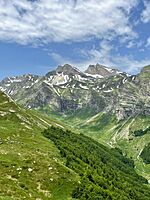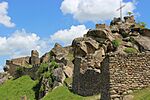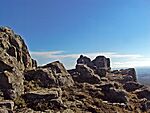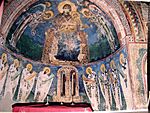List of World Heritage Sites in North Macedonia facts for kids
Imagine a special list of places around the world that are super important for everyone to protect! These are called World Heritage Sites. They are chosen by the United Nations Educational, Scientific and Cultural Organization. UNESCO is a part of the United Nations that helps protect important cultural and natural places.
These sites can be amazing old buildings, beautiful natural areas, or even whole cities. They are chosen because they have a special meaning for all of humanity. The idea for this list started in 1972.
North Macedonia became an independent country in 1991. It officially joined the UNESCO agreement in 1997. At that time, it was known as the former Yugoslav Republic of Macedonia. In 2019, the country's name officially changed to North Macedonia.
As of 2021, North Macedonia has two places on the main World Heritage list. It also has four other places on a "tentative list." This means these four places might be added to the main list in the future.
The first site added was the Natural and Cultural Heritage of the Ohrid region in 1979. In 2019, this site grew to include a part of the lake in Albania. This made it a site shared by two countries. In 2021, a special beech forest in Mavrovo National Park was added to another World Heritage Site. This forest is now part of a huge site shared with 17 other European countries!
The places on the tentative list are the Cave Slatinski Izvor, the rock formations called Markovi Kuli, the ancient Kokino observatory, and the Church of St George in Kurbinovo.
World Heritage Sites in North Macedonia
UNESCO chooses sites based on ten different rules or "criteria." Each place must meet at least one of these rules. Rules one to six are about culture, like old buildings or traditions. Rules seven to ten are about nature, like unique animals or landscapes.
* Transnational site
| Site Name | Picture | Location (Municipality) | Year Added | UNESCO Rules | What Makes It Special |
|---|---|---|---|---|---|
| Natural and Cultural Heritage of the Ohrid region* |  |
Ohrid | 1979 | i, iii, iv, vii (mixed) | The town of Ohrid is one of the oldest places where people have lived in Europe. You can find old remains from the Bronze Age all the way to the Middle Ages. It shows amazing Byzantine art and buildings, like the churches of St. John at Kaneo and St. Sophia. Ohrid also has the oldest Slavonic monastery and the first Slavonic University in the Balkans. Lake Ohrid is super old, from before the ice age. It's home to many unique plants and animals found nowhere else. In 2019, the site grew to include the Albanian part of the lake. |
| Ancient and Primeval Beech Forests of the Carpathians and Other Regions of Europe* |  |
Mavrovo and Rostuša | 2021 | 1133quater; ix (natural) | This site is made up of special forests in 18 different European countries. These forests show how European beech trees spread after the last ice age. They are perfect examples of how pure and mixed beech forests grow in different environments. The site was first listed in 2007 in Slovakia and Ukraine. It was later expanded to include forests in many other countries. The Dlaboka River valley in North Macedonia was added to this list in 2021. |
Sites North Macedonia Wants to Protect
Besides the sites already on the World Heritage list, countries can keep a "tentative list." These are places they think might be important enough to be nominated later. A site must be on this tentative list before it can be considered for the main World Heritage list. As of 2021, North Macedonia has four sites on its tentative list.
| Site Name | Picture | Location (Municipality) | Year Listed | UNESCO Rules | What Makes It Special |
|---|---|---|---|---|---|
| Cave Slatinski Izvor |  |
Makedonski Brod | 2004 | vii, viii, ix (natural) | This is the longest explored cave system in North Macedonia. The caves are found above the Slatina river near the village of Slatina, North Macedonia. They likely formed during the last ice age. You can see many cool cave formations inside the system. |
| Markovi Kuli |  |
Prilep | 2004 | vii, viii, ix (natural) | This is a unique natural rock formation made of volcanic and changed rocks. The way the land is shaped and its good location meant people have lived here for a very long time. We know this from at least the Bronze Age. |
| Archaeo-astronomical Site Kokino |  |
Staro Nagoričane | 2009 | i, ii, iii (cultural) | This is an ancient megalithic site, like a giant stone calendar, on top of the Tatićev Kamen mountain. It dates back to the Bronze Age. Stone markers show where the Sun rises on the longest day of summer and the shortest day of winter. They also show where it rises during spring and autumn. Plus, they mark where the full Moon rises at its highest and lowest points. This amazing site was discovered in 2001. |
| Church St. George (Sv Gjorgji) Kurbinovo |  |
Resen | 2020 | i, ii, iii (cultural) | This is an Orthodox monastery from the 12th century, located in the Prespa region. It's famous for its rare and beautiful wall paintings (frescoes). These frescoes are from a special time in Byzantine art called the Macedonian Renaissance. St George is the biggest church in the country that has only one main room. |
See also
 In Spanish: Anexo:Patrimonio de la Humanidad en Macedonia del Norte para niños
In Spanish: Anexo:Patrimonio de la Humanidad en Macedonia del Norte para niños

